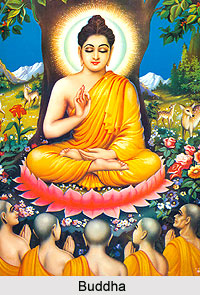 Buddhist influence on folk music in east India have been responsible in bringing out processions of dance and music with the image of Buddha among the general public all over eastern India is a historical fact covering several centuries, say, from the fourth to the seventh century A.D. Foreign travellers, Fa-hien, during the reign of Chandra Gupta II and Hiuen-Tsang during the reign of Harshavardhana, mentioned such festivals as witnessed by themselves.
Buddhist influence on folk music in east India have been responsible in bringing out processions of dance and music with the image of Buddha among the general public all over eastern India is a historical fact covering several centuries, say, from the fourth to the seventh century A.D. Foreign travellers, Fa-hien, during the reign of Chandra Gupta II and Hiuen-Tsang during the reign of Harshavardhana, mentioned such festivals as witnessed by themselves.
Abundant instances of the propagation of Mahayana Buddhistic ideas by Pala rulers from the eighth to the tenth century in the eastern region prove the spread of this tradition. The descendants of the great Palas faced trouble and gradually crumbled. History tells us of the rise of various small powers after them. The Senas were the champions of the Brahmanical system during the eleventh and twelfth centuries and responsible for the spread of Shaivism and Vaishnavism towards the later part of the thirteenth century. There is no record to tell us how music was introduced in the spread of Buddhist thought.
It is found that all over the northern region Buddhist musical performances are in vogue even now among the Tibeto-Burman tribes of the north eastern frontiers. Towards 1000 A.D. as indicated in the scripts of the regional language (apabhrarhsa), Caryagiti and Bajragiti, Mahayana Buddhist thoughts prevailed among common men of various areas. It has been already mentioned Caryagiti which contains forty-six complete and four incomplete lyrics of the earliest age preserving for us a record of the earliest specimens of regional languages like Oriya language, Bengali language and Assamese language and Maithili language of Bihar. It is also known that this form of language dates between A.D. 950 and A.D. 1200. The beginning of tradition of languages of this region can be related with these songs only. These songs which depict one aspect of the culture the impact of Buddhism on rural society of those days carry information about the psychological trend of the faith of the people. Buddhists were wiped out by the pressure of Brahmanism, Sakta, Saiva and Vaishnavic thoughts, and finally by Muslim invasion. Traces are now observed to exist in Dharma cult, Natha cult and Sahajiya cult.




















